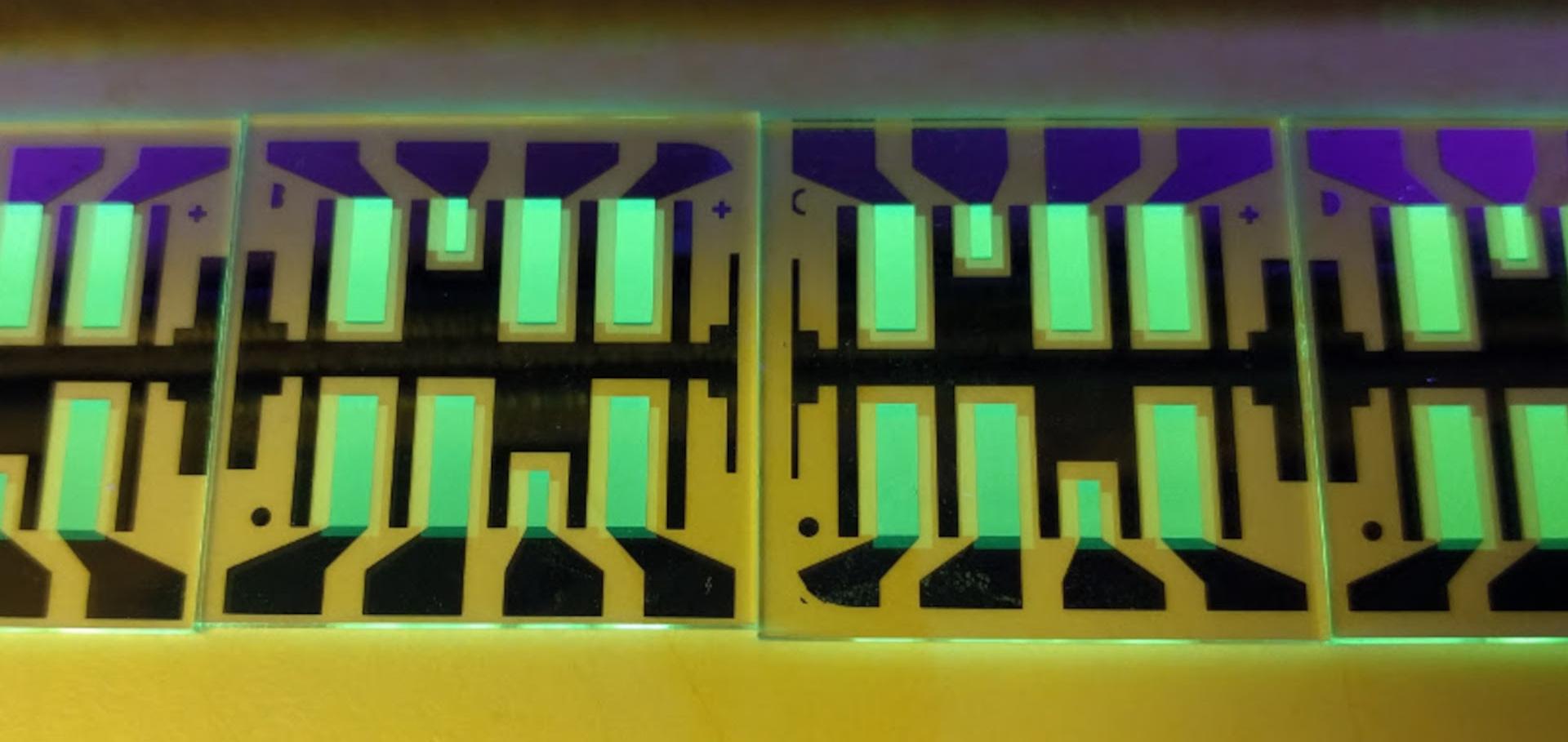Improved efficiency and lifetime in small molecule organic solar cells with optimized conductive polymer electrodes
Applied Physics Letters 99:11 (2011)
Abstract:
We report on efficient and stable ITO-free small molecule organic solar cells with conductive poly(3,4-ethylenedioxythiophene):poly(styrenesulfonate) (PEDOT:PSS) electrodes using a post-treatment process, causing selective removal of PSS. The solar cells with post-treated PEDOT:PSS electrodes show significantly improved short circuit current densities and efficiencies compared to untreated devices. Moreover, the removal of PSS by the post-treatment significantly improves the lifetime of devices, which are more resistant to loss of fill factor compared to untreated devices. © 2011 American Institute of Physics.Molecules for organic electronics studied one by one.
Phys Chem Chem Phys 13:32 (2011) 14421-14426
Abstract:
The electronic and geometrical structure of single difluoro-bora-1,3,5,7-tetraphenyl-aza-dipyrromethene (aza-BODIPY) molecules adsorbed on the Au(111) surface is investigated by low temperature scanning tunneling microscopy and spectroscopy in conjunction with ab initio density functional theory simulations of the density of states and of the interaction with the substrate. Our DFT calculations indicate that the aza-bodipy molecule forms a chemical bond with the Au(111) substrate, with distortion of the molecular geometry and significant charge transfer between the molecule and the substrate. Nevertheless, most likely due to the low corrugation of the Au(111) surface, diffusion of the molecule is observed for applied bias in excess of 1 V.Efficient organic tandem solar cells based on small molecules
Advanced Functional Materials 21:16 (2011) 3019-3028
Abstract:
In this paper, two vacuum processed single heterojunction organic solar cells with complementary absorption are described and the construction and optimization of tandem solar cells based on the combination of these heterojunctions demonstrated. The red-absorbing heterojunction consists of C60 and a fluorinated zinc phthalocyanine derivative (F4-ZnPc) that leads to a 0.1-0.15 V higher open circuit voltage Voc than the commonly used ZnPc. The second heterojunction incorporates C60 and a dicyanovinyl-capped sexithiophene derivative (DCV6T) that mainly absorbs in the green. The combination of both heterojunctions into one tandem solar cell leads to an absorption over the whole visible range of the sun spectrum. Thickness variations of the transparent p-doped optical spacer between both subcells in the tandem solar cell is shown to lead to a significant change in short circuit current density jsc due to optical interference effects, whereas Voc and fill factor are hardly affected. The maximum efficiency N of about 5.6% is found for a spacer thickness of 150-165 nm. Based on the optimized 165nm thick spacer, effects of intensity and angle of illumination, and temperature on a tandem device are investigated. Variations in illumination intensity lead to a linear change in jsc over three orders of magnitude and a nearly constant N in the range of 30 to 310 mW cm-2. Despite the stacked heterojunctions, the performance of the tandem device is robust against different illumination angles: jsc and N closely follow a cosine behavior between 0° and 70°. Investigations of the temperature behavior of the tandem device show an increase in N of 0.016 percentage points per Kelvin between -20 °C and 25 °C followed by a plateau up to 50 °C. Finally, further optimization of the tandem stack results in a certified N of (6.07 ± 0.24)% on (1.9893 ± 0.0060)cm2 (Fraunhofer ISE), i.e., areas large enough to be of relevance for modules. © 2011 WILEY-VCH Verlag GmbH & Co. KGaA, Weinheim.Quantitative estimation of electronic quality of zinc phthalocyanine thin films
Physical Review B - Condensed Matter and Materials Physics 84:7 (2011)
Abstract:
We determine the mobility-lifetime product (μτ) of free charge carriers in pristine zinc phthalocyanine (ZnPc) films using photocurrent measurements. The photocurrent is proportional to the free charge carrier generation efficiency (η) and the μτ product, and the carrier collection length is directly proportional to the latter. The μτ product is thus an important parameter for the electronic quality of a material. We further determine the dominant photocarrier generation mechanisms in ZnPc. The free carrier generation efficiency is estimated from total carrier collection and electric field-induced photoluminescence quenching measurements. Using η and the electric field dependence of the photocurrent, we estimate the μτ product of holes in ZnPc to be about 3×10-11 cm2/V. © 2011 American Physical Society.Side chain variations on a series of dicyanovinyl-terthiophenes: A photoinduced absorption study
Journal of Physical Chemistry A 115:30 (2011) 8437-8446


